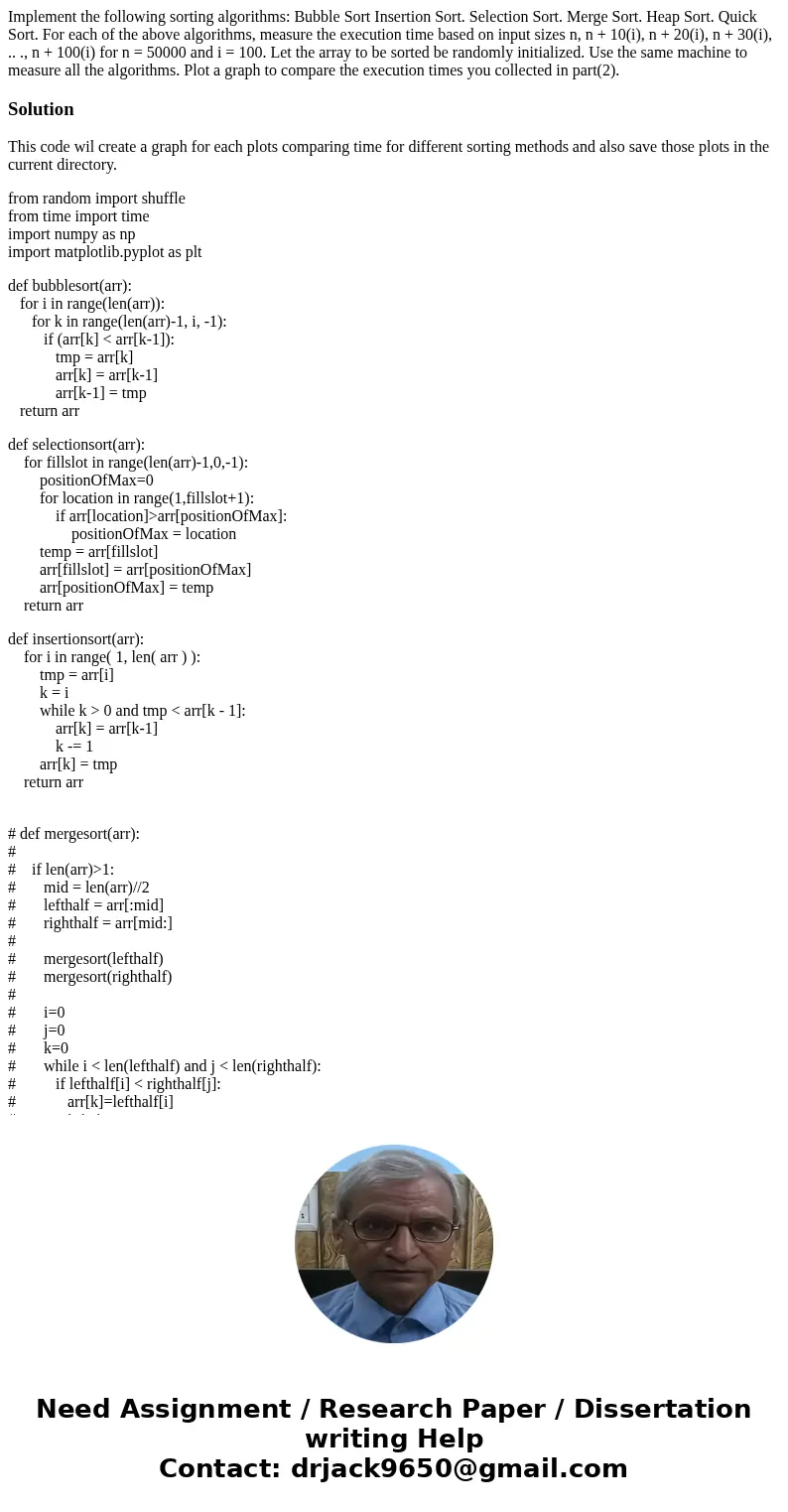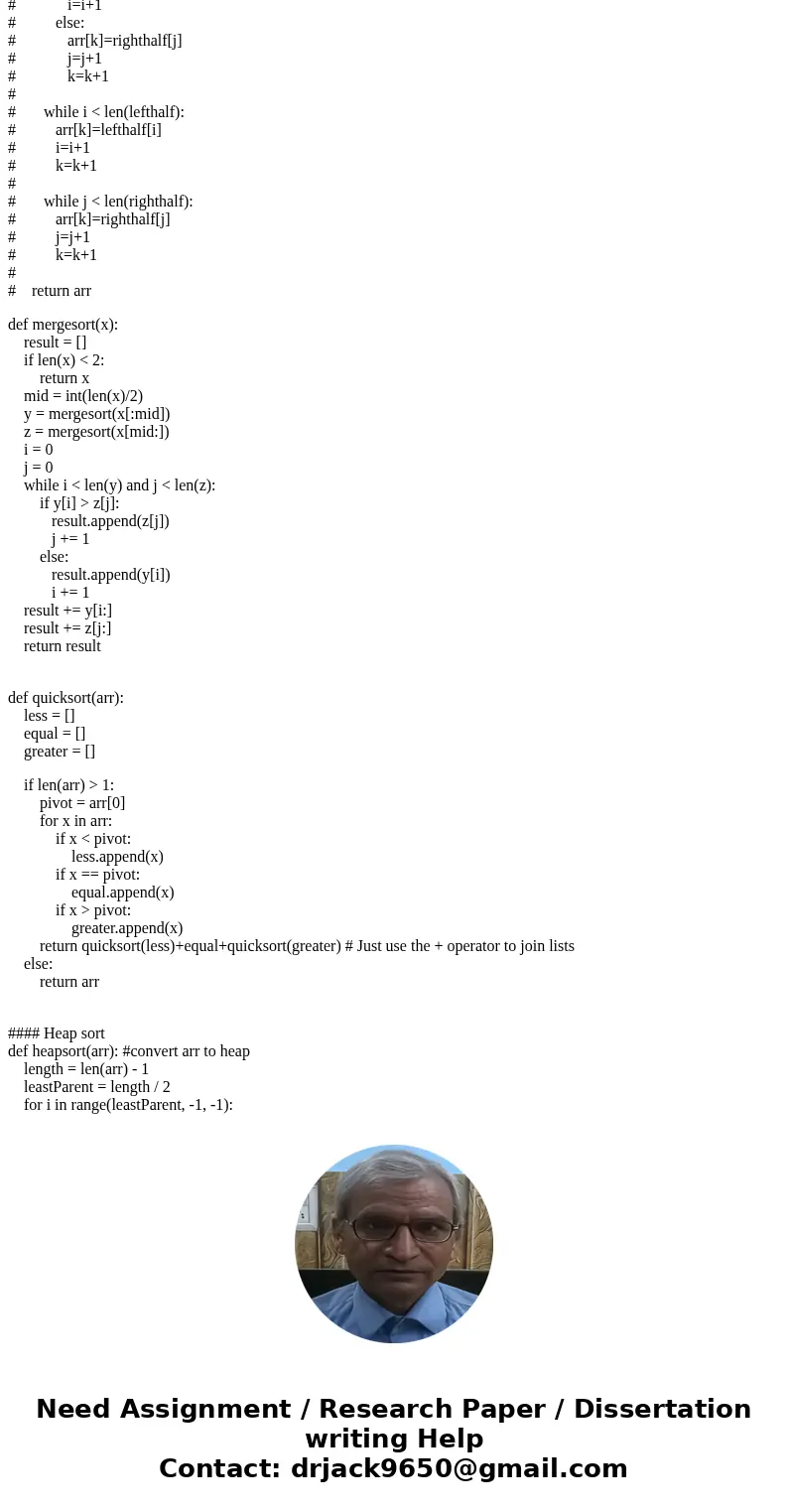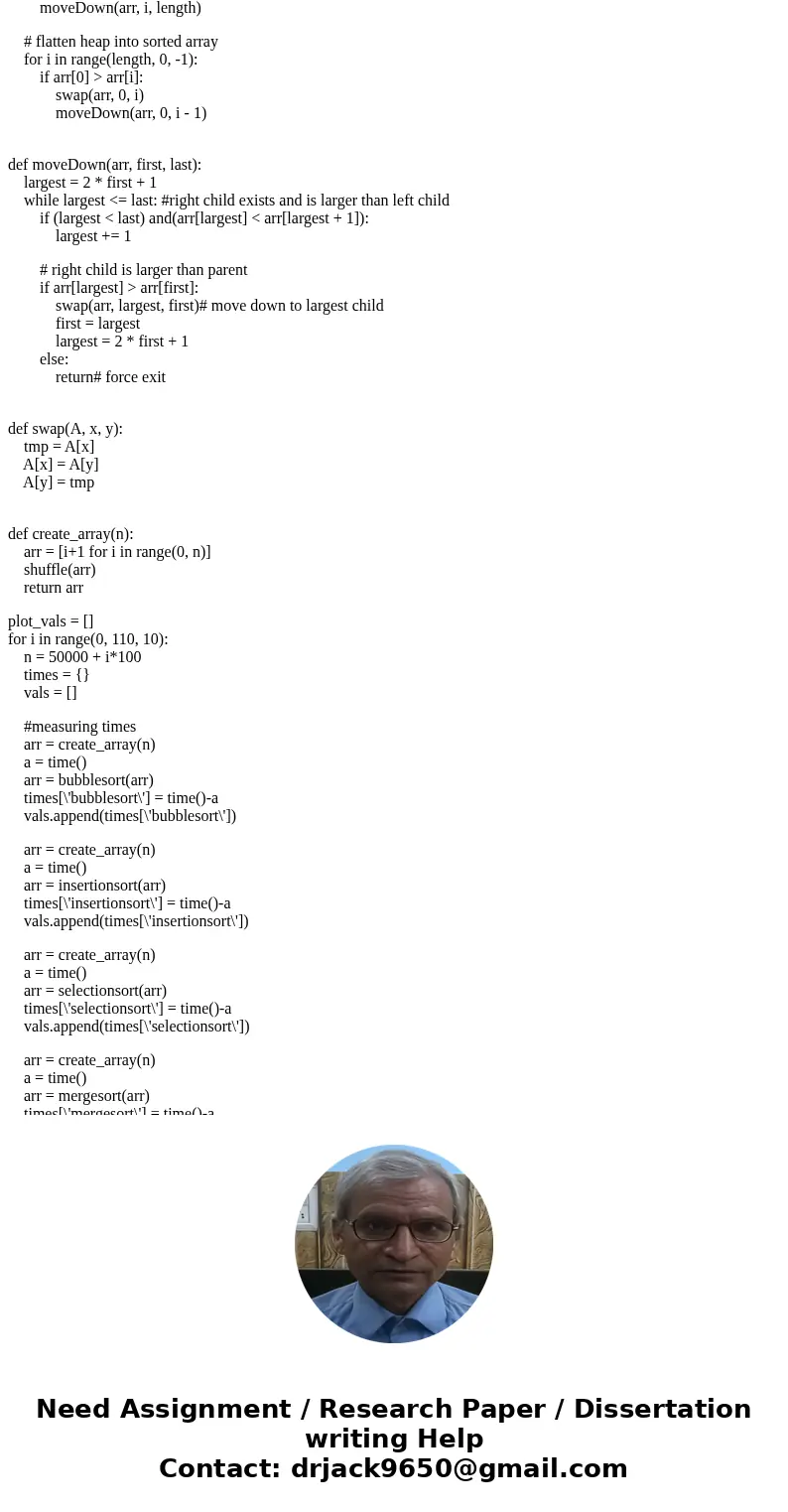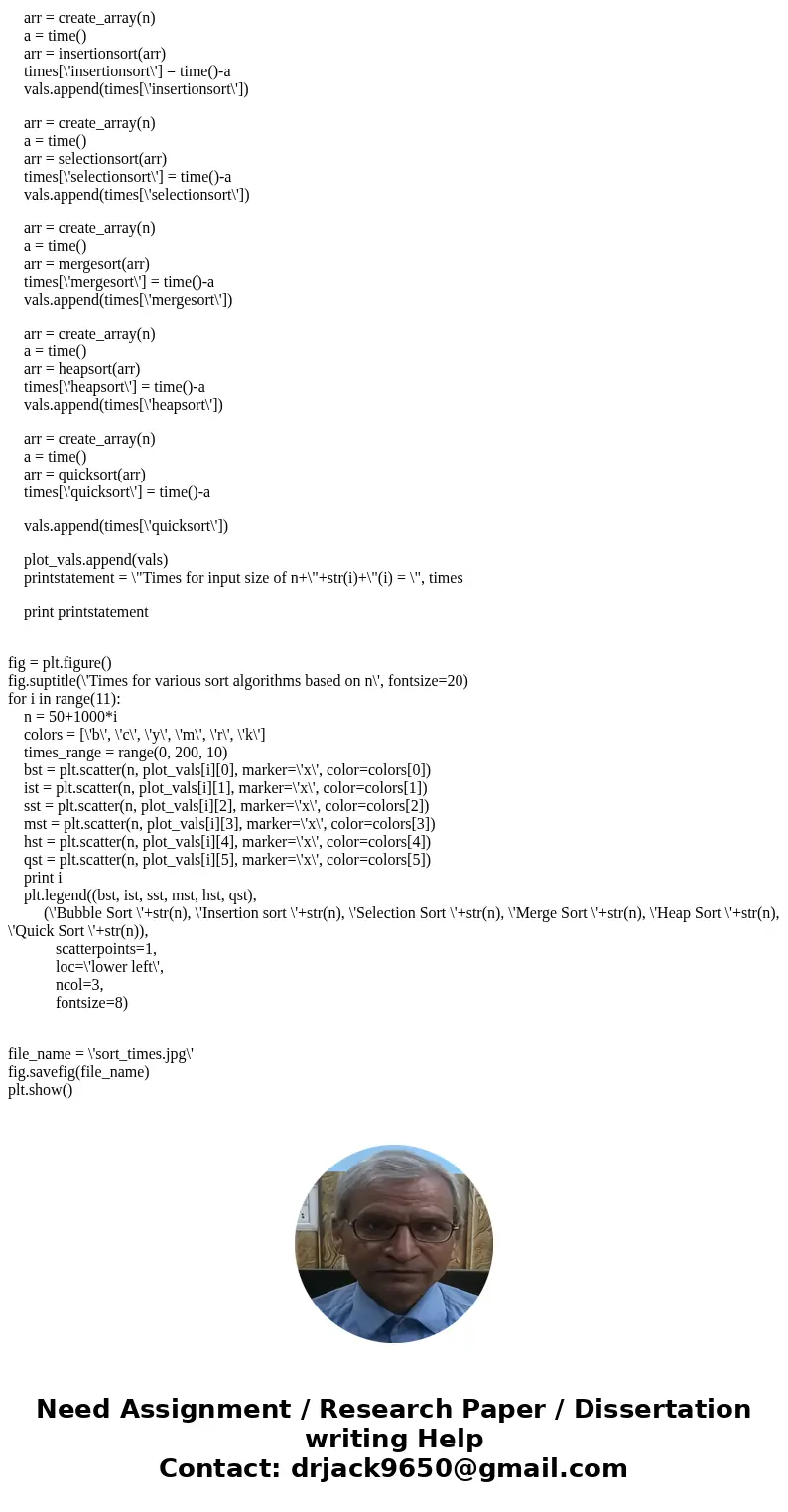Implement the following sorting algorithms Bubble Sort Inser
Solution
This code wil create a graph for each plots comparing time for different sorting methods and also save those plots in the current directory.
from random import shuffle
from time import time
import numpy as np
import matplotlib.pyplot as plt
def bubblesort(arr):
for i in range(len(arr)):
for k in range(len(arr)-1, i, -1):
if (arr[k] < arr[k-1]):
tmp = arr[k]
arr[k] = arr[k-1]
arr[k-1] = tmp
return arr
def selectionsort(arr):
for fillslot in range(len(arr)-1,0,-1):
positionOfMax=0
for location in range(1,fillslot+1):
if arr[location]>arr[positionOfMax]:
positionOfMax = location
temp = arr[fillslot]
arr[fillslot] = arr[positionOfMax]
arr[positionOfMax] = temp
return arr
def insertionsort(arr):
for i in range( 1, len( arr ) ):
tmp = arr[i]
k = i
while k > 0 and tmp < arr[k - 1]:
arr[k] = arr[k-1]
k -= 1
arr[k] = tmp
return arr
# def mergesort(arr):
#
# if len(arr)>1:
# mid = len(arr)//2
# lefthalf = arr[:mid]
# righthalf = arr[mid:]
#
# mergesort(lefthalf)
# mergesort(righthalf)
#
# i=0
# j=0
# k=0
# while i < len(lefthalf) and j < len(righthalf):
# if lefthalf[i] < righthalf[j]:
# arr[k]=lefthalf[i]
# i=i+1
# else:
# arr[k]=righthalf[j]
# j=j+1
# k=k+1
#
# while i < len(lefthalf):
# arr[k]=lefthalf[i]
# i=i+1
# k=k+1
#
# while j < len(righthalf):
# arr[k]=righthalf[j]
# j=j+1
# k=k+1
#
# return arr
def mergesort(x):
result = []
if len(x) < 2:
return x
mid = int(len(x)/2)
y = mergesort(x[:mid])
z = mergesort(x[mid:])
i = 0
j = 0
while i < len(y) and j < len(z):
if y[i] > z[j]:
result.append(z[j])
j += 1
else:
result.append(y[i])
i += 1
result += y[i:]
result += z[j:]
return result
def quicksort(arr):
less = []
equal = []
greater = []
if len(arr) > 1:
pivot = arr[0]
for x in arr:
if x < pivot:
less.append(x)
if x == pivot:
equal.append(x)
if x > pivot:
greater.append(x)
return quicksort(less)+equal+quicksort(greater) # Just use the + operator to join lists
else:
return arr
#### Heap sort
def heapsort(arr): #convert arr to heap
length = len(arr) - 1
leastParent = length / 2
for i in range(leastParent, -1, -1):
moveDown(arr, i, length)
# flatten heap into sorted array
for i in range(length, 0, -1):
if arr[0] > arr[i]:
swap(arr, 0, i)
moveDown(arr, 0, i - 1)
def moveDown(arr, first, last):
largest = 2 * first + 1
while largest <= last: #right child exists and is larger than left child
if (largest < last) and(arr[largest] < arr[largest + 1]):
largest += 1
# right child is larger than parent
if arr[largest] > arr[first]:
swap(arr, largest, first)# move down to largest child
first = largest
largest = 2 * first + 1
else:
return# force exit
def swap(A, x, y):
tmp = A[x]
A[x] = A[y]
A[y] = tmp
def create_array(n):
arr = [i+1 for i in range(0, n)]
shuffle(arr)
return arr
plot_vals = []
for i in range(0, 110, 10):
n = 50000 + i*100
times = {}
vals = []
#measuring times
arr = create_array(n)
a = time()
arr = bubblesort(arr)
times[\'bubblesort\'] = time()-a
vals.append(times[\'bubblesort\'])
arr = create_array(n)
a = time()
arr = insertionsort(arr)
times[\'insertionsort\'] = time()-a
vals.append(times[\'insertionsort\'])
arr = create_array(n)
a = time()
arr = selectionsort(arr)
times[\'selectionsort\'] = time()-a
vals.append(times[\'selectionsort\'])
arr = create_array(n)
a = time()
arr = mergesort(arr)
times[\'mergesort\'] = time()-a
vals.append(times[\'mergesort\'])
arr = create_array(n)
a = time()
arr = heapsort(arr)
times[\'heapsort\'] = time()-a
vals.append(times[\'heapsort\'])
arr = create_array(n)
a = time()
arr = quicksort(arr)
times[\'quicksort\'] = time()-a
vals.append(times[\'quicksort\'])
plot_vals.append(vals)
printstatement = \"Times for input size of n+\"+str(i)+\"(i) = \", times
print printstatement
fig = plt.figure()
fig.suptitle(\'Times for various sort algorithms based on n\', fontsize=20)
for i in range(11):
n = 50+1000*i
colors = [\'b\', \'c\', \'y\', \'m\', \'r\', \'k\']
times_range = range(0, 200, 10)
bst = plt.scatter(n, plot_vals[i][0], marker=\'x\', color=colors[0])
ist = plt.scatter(n, plot_vals[i][1], marker=\'x\', color=colors[1])
sst = plt.scatter(n, plot_vals[i][2], marker=\'x\', color=colors[2])
mst = plt.scatter(n, plot_vals[i][3], marker=\'x\', color=colors[3])
hst = plt.scatter(n, plot_vals[i][4], marker=\'x\', color=colors[4])
qst = plt.scatter(n, plot_vals[i][5], marker=\'x\', color=colors[5])
print i
plt.legend((bst, ist, sst, mst, hst, qst),
(\'Bubble Sort \'+str(n), \'Insertion sort \'+str(n), \'Selection Sort \'+str(n), \'Merge Sort \'+str(n), \'Heap Sort \'+str(n), \'Quick Sort \'+str(n)),
scatterpoints=1,
loc=\'lower left\',
ncol=3,
fontsize=8)
file_name = \'sort_times.jpg\'
fig.savefig(file_name)
plt.show()




 Homework Sourse
Homework Sourse